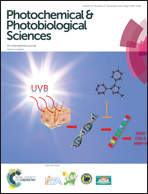Magnetic iron oxide modified pyropheophorbide-a fluorescence nanoparticles as photosensitizers for photodynamic therapy against ovarian cancer (SKOV-3) cells
Abstract
Magnetic iron oxide modified pyropheophorbide-a fluorescence nanoparticles, Fe3O4@SiO2@APTES@PPa (FSAP), were designed as magnetically targeted photodynamic antineoplastic agents and prepared through continuous covalent chemical modification on the surface of Fe3O4 nanoparticles. The properties of the intermediates and the final product were comprehensively characterized by transmission electron microscopy, powder X-ray diffraction analysis, Fourier transform infrared spectroscopy, vibrating sample magnetometry, zeta potential measurement, ultraviolet-visible absorption spectroscopy, fluorescence emission spectroscopy, and thermogravimetric analysis. In this work, we demonstrated the in vitro photodynamic therapy (PDT) of FSAP against ovarian cancer (SKOV-3) cells, which indicated that FSAP could be taken up successfully and showed low dark toxicity without irradiation, but remarkable phototoxicity after irradiation. Meanwhile, FSAP had showed good biocompatibility and low dark toxicity against normal cells in the biological experiments on mouse normal fibroblast cell lines (L929 cells). In addition, in the photochemical process of FSAP mediated photodynamic therapy, the Type-II photo-oxygenation process (generated singlet oxygen) played an important role in the induction of cell damage.


 Please wait while we load your content...
Please wait while we load your content...